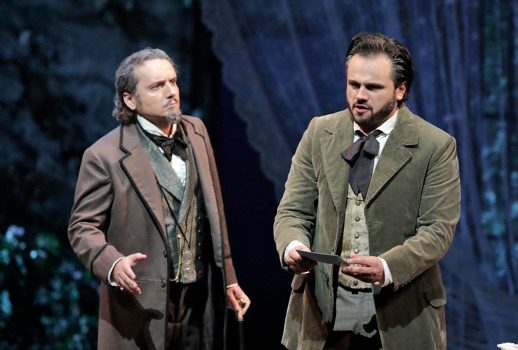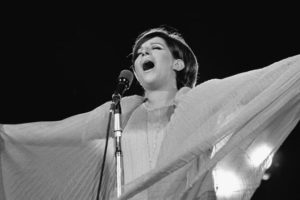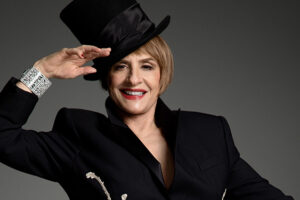

Tragically, we realize, it is only in Violetta’s sickness that she, Alfredo, and Giorgio find the reconciliation that they could have had in good health. However the regrets of those on stage might affect us, though, a great production also leaves us wondering whether the opera is in some measure about us.
Will we be able to tear down the artificial expectations that divide us from those we might love before it is too late? SF Opera’s current rendering of Verdi’s masterwork, featuring Aurelia Florian as Violetta, Atalla Ayan as Alfredo and Arture Rucinski as Giorgio, is one of those great productions.
The start of my Sunday matinee performance was inauspicious. There is something about the soft, ethereal openings of the preludes to Traviata (and Aida, I recall from last season) that gets San Francisco Opera-goers to discover respiratory illnesses they never knew they had.
Difficult though it was to focus on the music during the prelude, I’m happy to report that—at least to my knowledge—the entirety of the audience TB ward outlasted Violetta. The noise was a great injustice to the performers, since the prelude showed off Nicola Luisotti’s refined sense of natural pacing and the SF Opera Orchestra’s deep connection with this repertoire.
The reaching, grasping, violin fragments of the opening got just the right amount of space, and Verdi’s signature orchestral challenge—in which he gives different parts of the orchestra such divergent roles that they must pretend not to hear each other until they meet, as if by chance, at the end of the phrase—was negotiated with ease. Warm, organic melody lines swelled in the violas and cellos as ribbons of quick staccato accompaniment in the upper strings showed off Luisotti’s pinpoint control.
The orchestra continued to play at the highest level that I’ve heard from them for the rest of the performance. Soloistic details—from the weeping “white-toned” clarinets as Violetta pens her farewell letter to Alfredo to the “Di quell’amor” violin solos in the final act—were lovingly performed.
In the prolonged orchestral introduction to Act 3, in which Verdi draws together passionate love and impending death in a clear musical nod to Berlioz’ Symphonie Fantastique, the orchestra’s phrasing was intimate and imaginative, hopeful yet resigned—a perfect musical mirror of the figure wasting away upon the bed.
That figure was expertly played by the Romanian soprano Florian in her SF Opera debut. In a recent interview, Luisotti expressed his agreement with the cliché that the role of Violetta is so wide-ranging as to make it almost unsingable by a single person. Traviata’s three acts, so the conventional wisdom goes, require three different sopranos—coloratura, lyric, and dramatic.
It is almost inevitable that a singer playing Violetta will inhabit these three personalities with differing degrees of comfort. Indeed I found Florian to be more at home in the first and last acts than the second. But her performance for the entire opera existed on a spectrum from good to great.
In Act 1, she cultivated a confident, coquettish persona, only to shatter it in a “Sempre libera” whose surface-level self-assuredness grew increasingly frantic, nearly to hysteria. Dramatically it was a perfect encapsulation of Violetta’s situation—that of a regretful person whose long-term self-deception has led her to a breaking point.
Her vocal ornamentation on the aria was taut and energetic, her tone flute-like, and her pacing frenetic and wild.
Any gravity that Florian might have lost in the second act through her lighter tone she more than made up for with committed acting. Her desperate protestations against Giorgio’s demand that she abandon Alfredo gave way seamlessly to resignation and then clear-eyed nobility.
Florian’s wide-ranging stage persona, vocal mastery, and sense of tragic pacing all culminated in the final act. As she lay dying, her voice became straighter and more sincere to match the simplicity of Verdi’s orchestration.
Each breath of hope—the reading of Alfredo’s letter, his arrival, his promises that they would leave Paris together—worked like an amphetamine shot on her withering body.

The Brazilian tenor Ayan proved a worthy counterpart in the role of Alfredo. His warm, cello-like tone was delivered with a deep sense of dynamic control which made each of Alfredo’s many moments of decision seem monumental and inevitable.
Clearly more comfortable in the lower reaches of the tenor range, he was at his strongest in the opening of Act 2, as Alfredo prematurely celebrates his life of bucolic bliss. Moments that called for forceful delivery in the high vocal range, however, were somewhat less effective.
One Act 2 high C in particular came out thin. Dramatically, Ayan was a relatable hero—a blend of boyish naiveté, easily punctured ego, and determination.
There is something rather poetic in the fact that despite their irrepressible longing for one another, Florian and Ayan were musically at their best alone. In fact, perhaps the only eyebrow-raising musical moments of the opera came in Verdi’s infamous unaccompanied duet cadenzas.
The difficulty of tuning these moments, particularly in “Un dì felice” and “Parigi,” where Alfredo sings a melody line with Violetta adding the accompaniment up an octave, was obvious. In “Un dì felice,” Ayan’s tendency to run sharp in higher-range melodic lines created a wedge effect against Florian’s slight undershooting of her accompaniment.
And in “Parigi,” Ayan ran so high at moments that he had to self-correct by turning his ascending half-step phrase endings into essentially the same pitch. These cadenzas, which happily constitute only about a minute (though a poignant minute) of the music, were the only times during the opera when I wished I could push the fast-forward button.
Much more effective—and right on the mark intonationally—was the duet singing between Giorgio (Rucinski) and Florian. Brilliantly cast for the role, the Polish baritone delivered a strikingly direct, even brassy sound.
From an acting perspective, Giorgio is a demanding role—a hard but deeply feeling man who progresses painfully from honor-bound cruelty to sympathetic resoluteness to deep regret. Giorgio is also a difficult character for twenty-first century audiences to grapple with.
Verdi treats the old man’s desperation to preserve his family’s good name with the same level of musical sympathy that he accords to Violetta in her desperation to hold on to Alfredo. Perhaps for Verdi’s nineteenth century Italian audiences, this would have seemed a dilemma between two evenly matched alternatives—honor and love.
It is far more of a challenge for audiences living less honor-bound twenty-first century lives to sympathize with Giorgio’s plight. And likewise, it is challenging for twenty-first century singers to inhabit the character with the level of ardor that Verdi wrote.
Rucinski accomplished this masterfully, suppressing his more humane instincts as he held firm in the second act, and softening his tone in the final act as he begged Violetta’s forgiveness.
The ensemble cast, which in Traviata includes several named supporting roles, provided a good opportunity for SF Opera to show off several of its young artist Adler Fellows.
Particularly notable were first year Adler Fellow Amitai Pati, who turned in an energetic performance as Alfredo’s viscount friend Gastone, and Amina Edris, who contributed significantly to the tragic resignation of the third act as Violetta’s dutiful but wise servant Annina.
Chorus scenes, per usual at SF Opera, were well put-together. Particularly strong was the offstage chorus depicting a Mardi Gras festival outside Violetta’s window in the final act. The chorus’ crisp diction provided a stark foil to the tragedy unfolding onstage.
I sometimes find stage direction wanting in SF Opera performances: the recent production of Turandot, for instance, featured rather a lot of aimless pacing about the stage. In this Traviata, however, every aspect of Shawna Lucey’s staging was painstakingly thought out.
In the ensemble scenes, even the fourth or fifth most important thing happening onstage at any given time had just as much purpose and commitment behind it as the first. When the cheeky expression on the face of a supporting actor as he closes the doors to leave Alfredo and Violetta to their canoodling is memorable, that’s a sign of a well-directed production.
As far as the production itself, SF Opera opted for a conservative approach, bringing back its 1987 production of La Traviata and its director, John Copley, as producer. In an opera that needs no updating, the classic backdrop of sumptuous Parisian townhomes, lavish stone-walled country villas, and luxurious dinner attire fit perfectly.
In all, Traviata is, along with Madama Butterfly, one of the strongest productions of the last two seasons at SF Opera. When it comes to casting, directing, and orchestral playing, SF Opera is at its best on the classic Italian repertoire, and there’s certainly nothing wrong with that.
A deeply felt production that lays bare the timeless immediacy of Verdi’s greatest opera, La Traviata is highly recommended.
Photos: Cory Weaver/San Francisco Opera























Comments